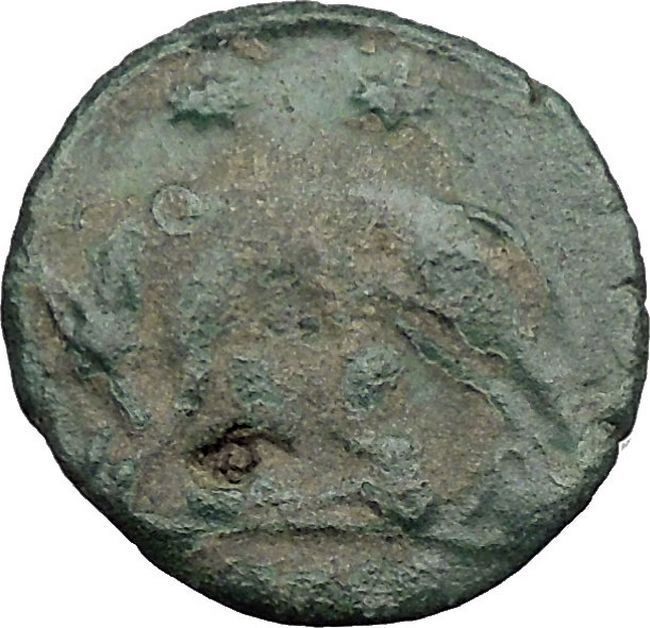|
Caracalla – Roman Emperor: 198-217 A.D.
Silver Denarius 18mm (3.51 grams) Struck 213 A.D.
Reference: RIC 308; Sear 6821; RSC 167.
ANTONINVS PIVS AVG GERM, laureate head right
MONETA AVG, Moneta standing half-left holding scales and cornucopiae.
You are bidding on the exact item pictured, provided with a Certificate of Authenticity and
Lifetime Guarantee of Authenticity.
The cornucopia (from Latin cornu copiae) or horn of plenty is a symbol of abundance and nourishment, commonly a large horn-shaped container overflowing with produce, flowers, nuts, other edibles, or wealth in some form. Originating in classical antiquity, it has continued as a symbol in Western art, and it is particularly associated with the Thanksgiving holiday in North America.

Allegorical depiction of the Roman goddess Abundantia with a cornucopia, by Rubens (ca. 1630)
In Mythology
Mythology offers multiple explanations of the origin of the cornucopia. One of the best-known involves the birth and nurturance of the infant Zeus, who had to be hidden from his devouring father Cronus. In a cave on Mount Ida on the island of Crete, baby Zeus was cared for and protected by a number of divine attendants, including the goat Amalthea (“Nourishing Goddess”), who fed him with her milk. The suckling future king of the gods had unusual abilities and strength, and in playing with his nursemaid accidentally broke off one of her horns, which then had the divine power to provide unending nourishment, as the foster mother had to the god.
In another myth, the cornucopia was created when Heracles (Roman Hercules) wrestled with the river god Achelous and wrenched off one of his horns; river gods were sometimes depicted as horned. This version is represented in the Achelous and Hercules mural painting by the American Regionalist artist Thomas Hart Benton.
The cornucopia became the attribute of several Greek and Roman deities, particularly those associated with the harvest, prosperity, or spiritual abundance, such as personifications of Earth (Gaia or Terra); the child Plutus, god of riches and son of the grain goddess Demeter; the nymph Maia; and Fortuna, the goddess of luck, who had the power to grant prosperity. In Roman Imperial cult, abstract Roman deities who fostered peace (pax Romana) and prosperity were also depicted with a cornucopia, including Abundantia, “Abundance” personified, and Annona, goddess of the grain supply to the city of Rome. Pluto, the classical ruler of the underworld in the mystery religions, was a giver of agricultural, mineral and spiritual wealth, and in art often holds a cornucopia to distinguish him from the gloomier Hades, who holds a drinking horn instead.
Modern depictions
In modern depictions, the cornucopia is typically a hollow, horn-shaped wicker basket filled with various kinds of festive fruit and vegetables. In North America, the cornucopia has come to be associated with Thanksgiving and the harvest. Cornucopia is also the name of the annual November Wine and Food celebration in Whistler, British Columbia, Canada. Two cornucopias are seen in the flag and state seal of Idaho. The Great Seal of North Carolina depicts Liberty standing and Plenty holding a cornucopia. The coat of arms of Colombia, Panama, Peru and Venezuela, and the Coat of Arms of the State of Victoria, Australia, also feature the cornucopia, symbolising prosperity.
The horn of plenty is used on body art and at Halloween, as it is a symbol of fertility, fortune and abundance.
Juno Moneta, an epithet of Juno, was the protectress of funds. As such, money in ancient Rome was coined in her temple. The Temple of Juno Moneta (Latin: Templum Iunonis Monetæ) was an ancient Roman temple that stood on the Arx or the citadel on the Capitoline Hill overlooking the Roman Forum. Located at the center of the city of Rome, it was the place where Roman coins were first minted, thereby initiating the ancient practice of associating mints with temples. In addition, it was the place where the books of the magistrates were deposited. The word “moneta” is where we get the words “money”, or “monetize”, used by writers such as Ovid, Martial, Juvenal, and Cicero. In several modern languages including Russian and Italian, moneta (Spanish moneda) is the word for “coin.” As with the goddess Moneta, Juno Moneta’s name is derived either from the Latin monēre, since, as protectress of funds, she “warned” of instability or more likely from the Greek “moneres” meaning “alone, unique”, an epithet that every mother has.
 Caracalla 198-217 A.D. Caracalla 198-217 A.D.
Caesar: 195-198 A.D. (under
|





 Caracalla 198-217 A.D.
Caracalla 198-217 A.D.


